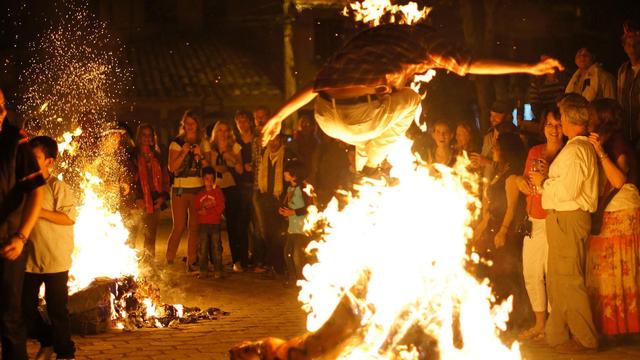How is the "burning of the Old Year", the Ecuadorian tradition of every December 31
New Year's Eve or New Year's Eve is the last night of the year in the Gregorian calendar. In Ecuador, the festival is celebrated with the “ Quema del Año Viejo ” which marks the end of the year. The burning is a ritual event in which a puppet is collectively made dressed in old clothes, stuffed with cardboard, newspaper, shavings, straw or sawdust and, often, with pyrotechnic material. Everything is lit in a campfire, with the intention that it will burn during midnight on December 31 and to kick off the first day of the New Year.
This ritualistic practice originates in Ecuador and is considered the most important event in the country at the end of each year. This tradition has been adopted in 12 of the 20 Latin American countries, especially in Colombia, Venezuela, Peru, Mexico, Argentina, Uruguay, Chile, Cuba, Panama, Nicaragua and Honduras.
The burning of the puppet is considered a symbolic cleansing ceremony of the year that is about to end, to drive away bad luck or negative energy. This fire festival represents the renewal of time, illusions and hopes, and could go back to Classical Greece, during the 6th and 5th centuries before Christ , where it was believed that the king should die cremated at the end of his reign. . Later a wooden figure came to represent the king and was burned on top of a huge pyre when the end of a certain period was near. With the arrival of the Gregorian year, for some cultures, burning came to symbolize the end of the calendar year.
In the Greek tradition, the new king begins to rule immediately after the death and cremation of the old king. The bearer of light represents the successor of the king who will rule in the new age.
In the case of Ecuador, the tradition is established in Guayaquil in 1842 when the Spaniards and mestizos try to quell the spread of yellow fever by burning the clothes of those killed by the disease. Then they tied the clothes in bundles and cremated them also with the intention that the deceased would be purified before their entrance to the new eternal life.

At that time, the inhabitants of Guayaquil feared an epidemic of yellow fever and to take care of their health they made straw wrappers and clothes to burn them in the streets on the last day of the year and achieve the purification of their city with the smoke and fire caused by the bonfires Over time, the purification ritual came to symbolize the old, sickly, and decaying versus the beginning of the new, healthy, and strong, leaving the past in ashes and defining the future in the light of the campfire.
For the mourning of the year that is leaving, which is the equivalent of the dying king of the Greeks or the deceased patient of Guayaquil, the widows and heirs accompany the old man until, at the last moment, he perishes. In the Ecuadorian tradition, a notary reads a will to distribute all the treasured inheritance in assets, virtues, penalties and debts, which is nothing more than satirizing what happened during the year that is leaving.
In Ecuadorian cities, such as Quito, Guayaquil, Cuenca, Loja and Tulcán, local governments even organize contests to reward the more ingenious and better elaborated stagings composed of Años Viejos, which usually include important events of the year in political matters. , sports or cultural. Some of these contests have even been held for almost half a century, although they have had to be suspended due to the current global health crisis.
The Años Viejos are cremated at midnight sharp on December 31, so that the flames reach January 1 of the new year. Attendees jump over the bonfire that forms, eat grapes, run with suitcases, wear bills in their shoes, wear colored underwear and hug their loved ones, offering words of encouragement and wishes for happiness. Meanwhile the stick figure is shaken by the explosion of the firecrackers that were mixed with the sawdust, paper or cardboard with which they were armed. In all the cities you can hear the rumblings, you can see the lights of the fireworks and in the sky you can see the smoke from the fires that accompany the petitions addressed to heaven by a deeply religious society.
In Guayaquil it has become a tradition to build large and very complex cardboard statues, which in some cases can even reach ten meters in height. During the afternoon of December 31, especially in the popular class areas, some men pose as the widows of the dying year, dress up as women in generally black clothes, and ask passers-by for money to buy liquor. The scene is usually accompanied by provocative dances and picaresque phrases, thus representing the widow's anger at her husband's departure. All of this is usually set to music with Colombian Caribbean cumbia.
In the houses, dolls are assembled to represent the Old Year, which are generally drunk accompanied by funny phrases and are displayed in the street so that people can see them. This custom unites neighbors and families in the elaboration of the dolls, in the decoration of their environment, in their cremation and in the celebrations that take place afterwards.
In Chile the festivity is called the “Monkey Burning” and it is a popular tradition that even in the town of Tocopilla, in the Antofagasta region, in the north of the country, the local authorities reward the best sculpture, generally of large size. dimensions and filled with firecrackers which is then burned and entertains the public that attends the incineration. In addition, the Salitrones are celebrated, which are burned together with the monkeys and which are bonfires of large amounts of saltpeter. Monkeys are produced mainly in Arica, Iquique, Tocopilla, María Elena, Calama, Antofagasta, Copiapó, Huasco, La Serena, Coquimbo and Penco.
In Argentina it has been called "Burning of the doll" and it is a tradition adopted in Greater Buenos Aires, especially in the city of La Plata, as well as in the neighboring regions of Berisso and Ensenada, since 1956.
KEEP READING:




